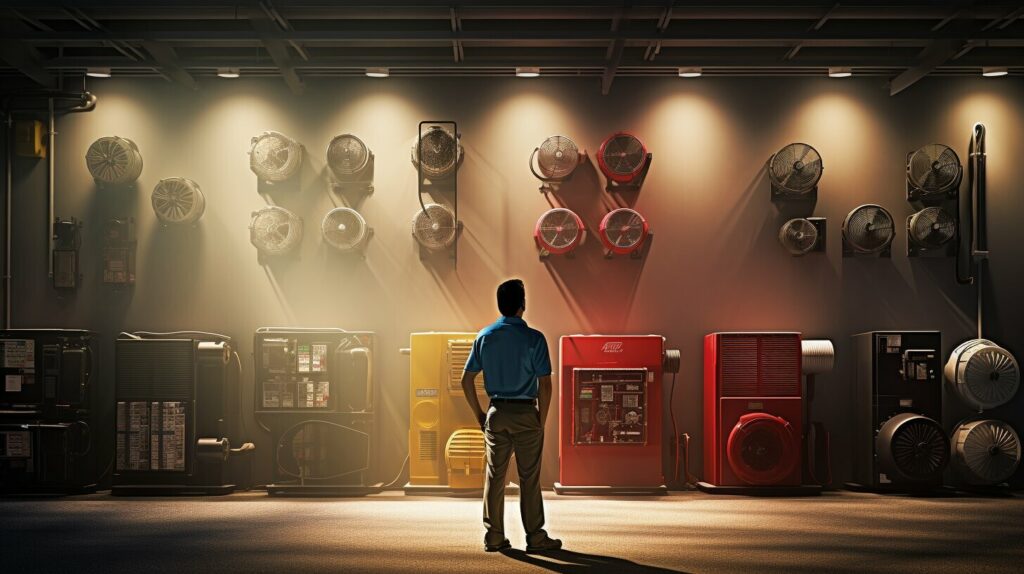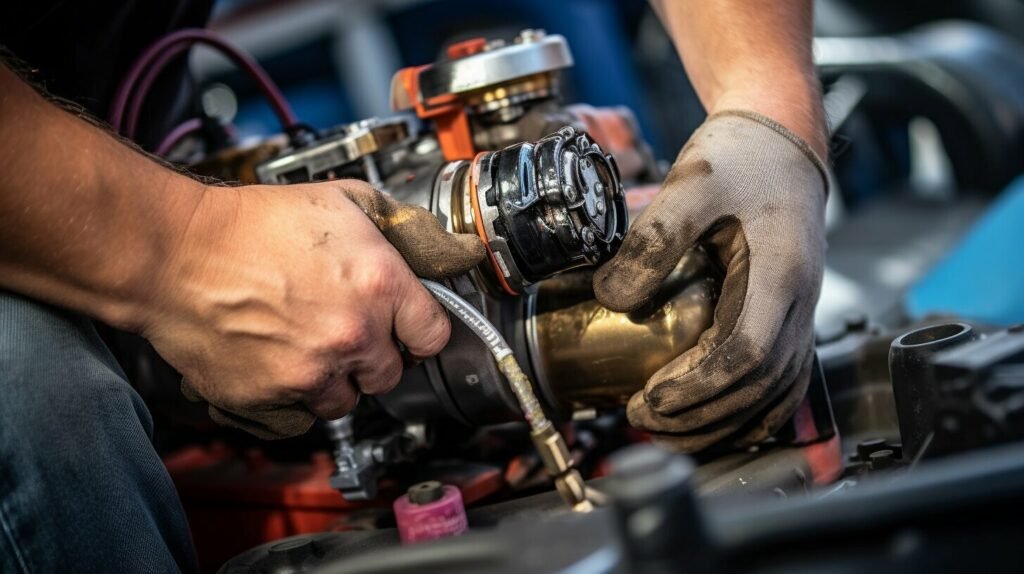Welcome to our comprehensive guide on mastering DIY air compressor home projects! If you’ve ever wanted to take your home improvements to the next level, an air compressor system can be an incredibly valuable tool. In this guide, we’ll cover everything you need to know about air compressors, from the basics to essential tools and accessories, setting up your system, and even some project ideas to get you started.
Whether you’re a seasoned DIY enthusiast or just starting out, this guide will provide you with the knowledge and skills to confidently tackle any project. So let’s dive in and explore the DIY air compressor home project world!
Understanding Air Compressor Basics
An air compressor is a machine that converts power into potential energy stored in compressed air. This compressed air can be used for DIY home projects requiring high-pressure air, such as painting, sanding, and powering pneumatic tools.
Two main types of air compressors are reciprocating and rotary screw compressors. Reciprocating compressors use a piston and cylinder to compress air, while rotary screw compressors use helical screws. Reciprocating compressors are best suited for intermittent use, while rotary screw compressors are more efficient and suitable for continuous use.
When choosing an air compressor, it is important to consider the amount of air needed (measured in cubic feet per minute or CFM), the maximum pressure required (measured in pounds per square inch or PSI), and the power source available. It’s important to select an air compressor with a CFM and PSI rating that exceeds the tools or equipment requirements.
| CFM rating | Suitable for |
|---|---|
| 2-3 CFM | Nail guns, staplers, and airbrushing |
| 4-5 CFM | Spray guns, sandblasters, and cut-off tools |
| 6+ CFM | Grinders, impact wrenches, and ratchets |
Air compressors require regular maintenance, such as oil changes, filter replacements, and draining moisture from the tank. It’s also important to monitor the compressor’s temperature and pressure levels and follow proper safety precautions when working with high-pressure air.
Understanding the basics of air compressors is crucial for completing DIY home projects. Take the time to research and select the right air compressor for your needs, and always prioritize safety when working with compressed air.

Choosing the Right Air Compressor for Your Home
When choosing the right air compressor for your home, it’s important to consider various factors, such as your budget, the types of projects you plan on doing, and the amount of space you have available for storage and operation.
One of the most important things to consider is the size and power of the compressor. For most DIY home projects, a small to medium-sized compressor with a capacity of 1-6 gallons and 0.5-1 horsepower will be sufficient. However, if you plan on tackling larger projects such as sandblasting or spray painting, you may need a more powerful compressor with a larger tank and higher horsepower.
The type of compressor is another important factor to consider. There are two main types of compressors: reciprocating and rotary screw compressors. Reciprocating compressors are more affordable and are suitable for smaller projects, while rotary screw compressors are more expensive but offer greater power and efficiency and are better suited for larger projects.
Additionally, you’ll want to consider the features and accessories of the compressor. Look for compressors with a pressure regulator, which will allow you to adjust the pressure output based on your project needs. Other important accessories include hoses, fittings, and air tools, allowing you to get the most out of your compressor.

Finally, consider your budget. Air compressors can range in price from under $100 to over $1,000, so it’s important to determine how much you’re willing to spend before purchasing. Remember that a high-quality compressor will be a worthwhile investment in the long run, as it will be more efficient, durable, and offer greater versatility and power for a wider range of projects.
Essential Tools and Accessories for Air Compressor Systems
An air compressor system comprises various components that work together to ensure optimal performance and efficiency. To ensure your system is functioning properly, having the right tools and accessories on hand is crucial. Here are some essential items you should consider:
| Tool/Accessory | Description |
|---|---|
| Air Hose | Used to connect the compressor to other components, such as a spray gun or air tool. Make sure to choose a hose that has the appropriate diameter and length for your needs. |
| Regulator | Used to connect the compressor to other components, such as a spray gun or air tool. Make sure to choose a hose with the appropriate diameter and length for your needs. |
| Filter | It helps remove dirt and debris from the air before it reaches your tools. Choose a filter with a micron rating that matches your needs. |
| Oil | Some compressors require oil to ensure proper lubrication and prevent damage. Check your user manual to see if your compressor needs oil, and if so, what type. |
| Nozzles and Attachments | Various nozzles and attachments can be used with air compressors to perform specific tasks, such as inflating tires or blowing debris. Make sure to choose attachments that are compatible with your compressor. |
Having these tools and accessories on hand will ensure that your air compressor system is functioning properly and make your DIY projects easier and more efficient.
Looking for More Accessories?
If you’re looking for more accessories to enhance your air compressor system, consider investing in a pressure switch, a compressor pump, or a drain valve. These items can help improve the performance and lifespan of your system.

It’s important to note that different air compressor systems may require different tools and accessories. Always consult your user manual or a professional if you’re not sure what you need.
Setting Up Your DIY Air Compressor System
Now that you have chosen the right air compressor for your home and gathered all the necessary tools and accessories, it’s time to set up your DIY air compressor system. Follow these steps to get started:
Gather Your Materials
Before you begin, ensure you have all the materials required for the installation process, including pipes, fittings, valves, and other necessary components. Use high-quality materials to ensure your system lasts longer.
Find the Perfect Spot
Choose a well-ventilated, dry area that’s easily accessible and provides enough space to accommodate your air compressor system. Ensure the surface is flat, level, and capable of supporting the compressor’s weight and other components.
Install the Compressor
Determine where you want to place your air compressor and secure it. You can use specially designed mounts or brackets for this purpose. Ensure the compressor is level and stable to prevent any vibrations or movements that may cause damage or safety hazards.
Connect the Pipes and Fittings
Connect the pipes and fittings according to the manufacturer’s instructions, ensuring a secure and airtight fit. Avoid using Teflon tape or other sealants that may contaminate the air supply or cause leaks.
| Tip | Use union fittings or quick-connect couplings that allow for easy disconnection and reconnection of different components. This way, you can easily expand or reconfigure your air compressor system in the future. |
|---|
Install the Regulator and Filters
Install the regulator and filters to control the pressure and quality of the compressed air. Make sure to choose the appropriate size and type of regulator and filter for your specific needs. Follow the manufacturer’s instructions for installation and maintenance.
Test Your System
Once you have completed the installation process, test your system for leaks, pressure drops, or other issues. Adjust the settings as necessary to achieve the desired pressure and flow rate. Use a pressure gauge or other monitoring tools to ensure your system functions properly.

By following these steps, you can easily set up your DIY air compressor system. With a properly installed system, you can tackle various home projects and DIY tasks, from inflating tires and cleaning air filters to sandblasting and painting.
Maintenance and Troubleshooting Tips for Air Compressor Systems
Keeping your air compressor system in good condition ensures that it operates safely and efficiently and that it lasts for a long time. Here are some maintenance and troubleshooting tips to help you maintain your air compressor system.
Regular Maintenance
Regular maintenance helps prevent breakdowns and ensures that your air compressor runs smoothly. Here are some things you should do regularly:
- Check the oil level and change it as needed.
- Drain the moisture from the tank.
- Check the air filter and clean or replace it.
- Inspect hoses and fittings for leaks or damage.
- Check the safety valve to make sure it’s functioning correctly.
Refer to the manufacturer’s instructions for specific maintenance requirements for your air compressor.
Troubleshooting Tips
If your air compressor isn’t working properly, try these troubleshooting tips before calling a professional:
| Problem | Possible Cause | Solution |
|---|---|---|
| The compressor runs but doesn’t build pressure | Power supply, pressure switch, or motor problems. | Check power supply and pressure switch. If the problem persists, consult a professional technician. |
| Air leaks | Loose fittings or damaged hoses. | Tighten fittings or replace hoses. |
| Compressor runs but doesn’t build pressure | Leak, worn piston rings, or malfunctioning valves. | Check the power supply and pressure switch. If the problem persists, consult a professional technician. |
If you’re unsure how to troubleshoot your air compressor, refer to the manufacturer’s instructions or consult a professional technician.
Regular maintenance and troubleshooting can help keep your air compressor system running safely and efficiently. By following these tips, you can avoid costly repairs and extend the life of your air compressor.

DIY Air Compressor Projects for Home
Now that you have set up your air compressor system, it’s time to put it to work! You can complete countless DIY projects around the house with the help of your air compressor. Here are a few ideas to get you started:
Painting Projects
One of the most common uses for an air compressor is for painting projects. With the help of a paint sprayer, you can quickly and easily paint large areas, such as walls or fences. You can also use your air compressor to spray paint furniture or other smaller items for a smooth, professional finish.

Image source:
Carpentry Projects
Your air compressor can also be used for many carpentry projects. For example, you can use a nail or staple gun to build furniture or install trim. With the right attachments, you can use your air compressor to power saws, drills, and other tools.
Cleaning Projects
Another useful application of an air compressor is for cleaning tasks. You can use compressed air to blow debris out of gutters, clean dust, and dirt from hard-to-reach areas, and even blow up inflatable pool toys or air mattresses.
Automotive Projects
If you enjoy working on cars, an air compressor is an invaluable tool. You can use it to power impact wrenches, air ratchets, and other automotive tools. You can also use compressed air to clean parts and blow out debris from under the hood.
With a little creativity, the possibilities for DIY projects with your air compressor are endless. Just take necessary safety precautions and always follow the manufacturer’s instructions for your tools and accessories.
Safety Precautions When Working with Air Compressors
While DIY air compressor projects can be fun and rewarding, safety should always come first. Air compressors can be dangerous if improperly used, causing serious injuries or even fatalities. Here are some safety precautions to keep in mind:
- Read the manual: Before using your air compressor for the first time, read the manual carefully and follow the instructions provided by the manufacturer. Not all air compressors are created equal, and you need to know your model’s specific safety features and precautions.
- Wear protective gear: When working with air compressors, always wear eye and ear protection, gloves, and appropriate clothing. Flying debris and loud noise can cause serious injuries and hearing damage if not protected.
- Keep the work area clean and clear: Make sure your work area is free from clutter and debris, which can cause accidents or injury. Keep all power cords and air hoses away from the work area to avoid tripping hazards.
- Keep children and pets away: Never allow children or pets near your air compressor when it is in use. Ensure they cannot access the work area, cords, or hoses.
- Never exceed the recommended pressure: Always check the maximum pressure rating of your air compressor and never exceed it. Overpressurizing the tank can cause it to rupture, leading to serious injury.
- Monitor the air compressor: Always monitor your air compressor while in use. Check for leaks, unusual sounds, or overheating, and shut it off immediately if you notice anything unusual.
- Properly store your air compressor: After using it, always turn it off and allow it to cool down. Properly store it in a dry, well-ventilated area.
Following these safety precautions can help prevent accidents and injuries when working with air compressors. Always remember to prioritize safety to ensure a successful and stress-free DIY air compressor project.

Tips for Upgrading and Expanding Your Air Compressor System
If you are looking to get more use out of your air compressor system, it may be time to consider upgrading or expanding it. Here are some tips to help you get started.
1. Determine Your Needs
The first step in upgrading or expanding your air compressor system is to determine your needs. What projects do you plan on doing? How much power will you need? Consider factors such as the type of tools you’ll be using and the amount of space you have available. Once you have a clear idea of your needs, you can start shopping for the right equipment.
2. Buy Quality Equipment
When upgrading or expanding your air compressor system, it’s important to invest in quality equipment. Look for products from reputable brands and check customer reviews before making a purchase. While you may be able to save money by buying cheaper equipment, it may end up costing you more in the long run due to maintenance and repairs.
3. Upgrade Your Compressor
If your current compressor isn’t meeting your needs, consider upgrading to a larger model. This will give you more power and allow you to take on bigger projects. You may also want to consider upgrading to a compressor with a higher CFM (cubic feet per minute) rating, which will allow you to run multiple tools at once.
4. Add Accessories
Another way to upgrade and expand your air compressor system is to add accessories. Some useful accessories include air hoses, fittings, and quick-connect couplers. You may also want to consider adding a regulator to your system, which will allow you to adjust the pressure of the air coming out of your compressor.
5. Use Piping
If you are expanding your air compressor system, it’s important to use piping to ensure that the air flows smoothly and efficiently. Consider using copper or aluminum piping, which is less likely to rust and corrode than other materials. Make sure to choose the right size piping for your needs and use proper fittings to prevent leaks.
6. Keep Your System Maintained
Finally, it’s important to keep your air compressor system well-maintained to ensure that it continues to work properly. This includes regularly checking and changing the oil, cleaning or replacing air filters, and checking for leaks. By keeping your system maintained, you can extend its lifespan and avoid costly repairs.
By following these tips, you can upgrade and expand your air compressor system to better meet your needs. Remember to always prioritize safety when working with air compressors and other power tools. Happy DIY-ing!

Frequently Asked Questions (FAQ) about DIY Air Compressor Home Projects
We hope these FAQs have helped answer some of your questions about DIY air compressor home projects. Always prioritize safety and consult the manufacturer’s instructions before operating your air compressor system. Happy DIY-ing!
What type of air compressor should I use for home projects?
It depends on the type of project you’re working on. If you’re doing light-duty tasks like inflating tires or using a nail gun, a small portable air compressor should work just fine. However, for heavy-duty tasks like sandblasting or using air impact wrenches, you’ll need a larger air compressor with a higher CFM (Cubic Feet per Minute) rating.
How do I choose the right air compressor for my home?
Consider the type of projects you’ll be working on and the air tools you’ll be using. Look for an air compressor with the appropriate CFM rating and tank size to power your tools. Don’t forget to also consider the noise level and portability of the air compressor.
Do I need any special tools or accessories for my air compressor system?
Yes, you’ll need a few essential tools and accessories like air hoses, fittings, and regulators. You may also want to consider getting a moisture trap and a filter to ensure dry and clean air.
How do I set up my air compressor system?
First, make sure you have all the necessary tools and accessories. Then, locate a suitable location for your air compressor and install it according to the manufacturer’s instructions. Finally, connect your air tools to the compressor using appropriate hoses and fittings.
How often should I maintain my air compressor system?
It’s important to perform regular maintenance on your air compressor system to ensure it runs efficiently and safely. Change the oil and air filter as recommended by the manufacturer, check for leaks, and drain the tank regularly to remove any accumulated moisture.
What are some common issues with air compressor systems and how can I troubleshoot them?
Common issues include leaks, low air pressure, and compressor won’t start. Check for leaks and tighten any loose fittings, make sure the tank pressure is set correctly, and check the power cord and motor if the compressor won’t start.
What are some DIY air compressor projects I can do at home?
There are a variety of home DIY projects you can do with an air compressor, including painting, sanding, and inflating tires. You can also use it for automotive maintenance, woodworking, and even cleaning.
How can I ensure safety when working with air compressors?
Always wear appropriate safety gear like eye and ear protection, and avoid wearing loose clothing or jewelry that can get caught in the compressor. Never exceed the recommended pressure rating for your tools and regularly check for leaks or damage to hoses and fittings.
How can I upgrade or expand my air compressor system?
You can upgrade your system by getting a larger tank or compressor with a higher CFM rating, or by adding more accessories like a drying system or additional outlets. Just make sure your electrical circuit can handle the additional load.

